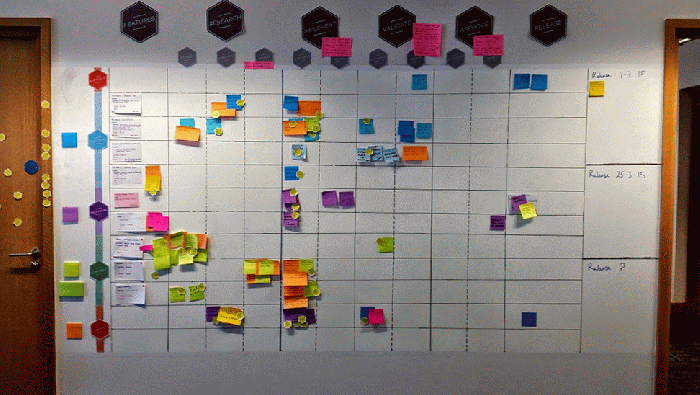Digital
Our Approach to Agile and Kanban
April 28, 2015 by Jono Ellis No Comments | Category Digital Public Services, mygov.scot
This is a post by Jono Ellis, our Social Media Manager
As part of our 100 day drive more of our team have been getting trained up on how to get the most out of working in an Agile environment and we thought we could share some of their experiences here. In the office we are already using Agile practices and we run all our work through our Kanban board – we’ve mentioned both Agile and Kanban before but it’s a good idea to remind ourselves what they are:
Agile software development is a group of software development methods in which requirements and solutions evolve through collaboration between self-organising, cross-functional teams. It promotes adaptive planning, evolutionary development, early delivery, continuous improvement, and encourages rapid and flexible response to change. – Wikipedia
The Kanban Method (看板) (literally sign or large visual board in Kanji) is a management method for: improving service delivery, catalysing improvements and evolving the business model to be fit-for-purpose – Lean Kanban

The animation above shows what this means on a day to day basis – features, bugs, technical changes and content all get cards or sticky notes and those items progress onto and then along the Kanban board as work progresses, eventually dropping off when that item is added to the live site. To us Agile and Kanban are more than just a board on a wall and a few rituals – it is a way of making better decisions, improve our collaboration, deliver more value and increase the quality of our product – so here are a few different takes on the recent learnings:
What was the big idea? Modern software development has been suffering by operating in a mode of production rooted in manufacturing, which doesn’t work [for knowledge work]. We need a new method.
What was your big surprise? A survey of software development that illustrated the amount of features created that were never used.
What’s your big question? Convert theory to practise – how?
– Peter Smith, Product Owner
What was the big idea? Equip me with new skills so that I can contribute better to the programme.
What was your big surprise? Working towards deadline can create waste – if you finish early you could end up with waste [e.g. extra features or gold-plating] trying to deliver at the right time.
What’s your big question? How to create a feedback loop early enough to avoid delivering what is not needed.
– Raphael Chinwuba, Business Analyst
What was the big idea? Getting people to think about a different way of working and how best to deliver something of value to citizens as early as possible.
What was your big surprise? Touching upon the history of manufacturing through comparing the idea of people on a production line and people as master craftsman.
What’s your big question? It has made me want to explore new methods of working in more detail – including getting involved in initiatives like responsive.org/.
– Calum Shepherd, Head of Digital Strategy
What was the big idea? The organisation needs to change. Adopting Agile thinking can enable quality, better flow and added value.
What was your big surprise? What matters is not delivering “on time” but speed of delivery. Getting my head around for clients/customers delivering on time shouldn’t be a key deliverable. The assumption is almost “we know better”. Really interested to appreciate how we do this in relation to the “Quality, Flow, value” arena. Looking forward to working through it!
What’s your big question? Question the attitude that all other methodologies are wrong and project have failed because they were waterfall. Believe adopting Agile best practices can indeed benefit delivery but there are fundamental ground rules (mission statement, objectives, strategy, etc.) that must be established and adhered to.
– Grainne Mcintyre, Business Analyst

Tags: Product

Leave a comment